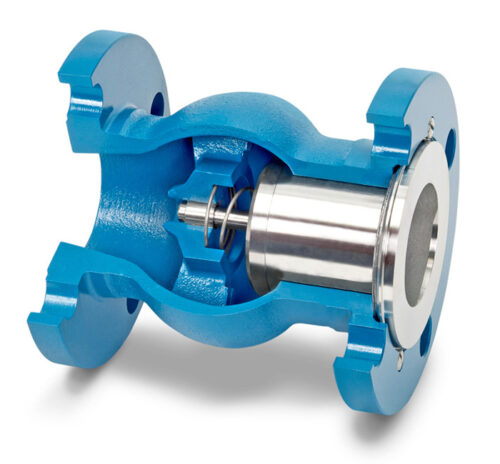Check Valve Selection 101: Types & Applications
 Check valves, sometimes called non-return valves, are valves with two openings or ports that allow fluid flow in only one direction. Fluid enters through one port and exits the valve through the other. Industrial fluid systems in power plants, chemical plants, water and wastewater treatment facilities, oil fields, refinery applications, and other industries rely on check valves to prevent fluid flow back to the source. For instance, check valves are often used to transfer fuel and an oxidizer in separate lines to a mixing vessel without the fuel or oxidizer flowing back into the initial gas or oxidizer cylinders.
Check valves, sometimes called non-return valves, are valves with two openings or ports that allow fluid flow in only one direction. Fluid enters through one port and exits the valve through the other. Industrial fluid systems in power plants, chemical plants, water and wastewater treatment facilities, oil fields, refinery applications, and other industries rely on check valves to prevent fluid flow back to the source. For instance, check valves are often used to transfer fuel and an oxidizer in separate lines to a mixing vessel without the fuel or oxidizer flowing back into the initial gas or oxidizer cylinders.
Selecting the right check valve for a specific application is essential to achieving optimal performance, reliability, and service life. Here, we will explore the various check valve types and applications to help you decide on the best option for your project.
Important Check Valve Selection Criteria
When selecting a check valve for an application, consider the following:
- Initial Costs: Consider the cost of the valve and any installation costs associated with the check valve.
- Maintenance Costs: The cost of maintenance or repairs can vary depending on the complexity of the valve. Improper, oversized check valves can add dramatically to life cycle maintenance costs.
- Head Loss and Energy Costs: Head loss is a characteristic of check valves determined by the internal valve design and degree of opening. Restriction in the valve opening (compared to the pipeline opening) will result in increased head loss, which can lead to higher energy costs.
- Non-Slam Characteristics: Proper valve selection is critical in preventing water hammer and slamming during operation. Consider a check valve that offers compatible closing characteristics to the dynamics of the pumping system.
- Fluid Compatibility: Certain valves are designed for different fluid viscosities, sediment, and particles. Select the valve that is compatible with the medium passing through it.
- Sealing Ability: Consider the proper sealing for your application, whether it’s gas-tight, bubble-tight, or drop-tight sealing.
- Flow Characteristics: Every check valve has its distinct flow characteristics. Matching the right characteristics to your needs can minimize the potential for reverse flow or surges on sudden pump shutdown.
- Valve Size and Pressure Rate: Check valves come in a variety of sizes and pressure classes. Ensure your valve is sized appropriately for the system’s flow rate and can withstand the operating pressure. Undersized or oversized valves may lead to inefficiencies or even system failure.
- Materials Selection: Based on certain criteria such as compatibility of the fluid type, temperature, and corrosiveness, material selection is crucial for the reliability of the valve.
- Installation Orientation: Consider the orientation of the check valve installation. Some check valves cannot be installed both horizontally or vertically.
- Application Considerations: Different applications have unique requirements, such as sanitary standards for food or fire safety for oil and gas. Ensure your check valve complies with any specific industry regulations.
Types of Check Valves and Their Applications
There are several types of check valves designed for distinct applications. Some of the most common check valves include lift, swing, and ball check valves.
Lift Check Valves
Lift check valves are economical, automatic valves with no external moving parts for reliable operation. Specific types of lift check valves include nozzle check valves, in-line check valves, and piston check valves. The main closure mechanism in a lift check valve is typically a disc that lifts off the valve seat when subject to inlet pressure, allowing normal fluid flow past the disc and seat, then through the outlet port. The motion of the disc is guided in a straight line, so the valve can later reseat properly. A spring or gravity moves the disc back into the seat when the upstream fluid pressure drops, stopping the fluid flow. DFT® check valves can be installed in any orientation: horizontal, vertical flow up, or vertical flow down. These types of valves are commonly found in applications where backflow prevention is critical.
Swing Check Valves
Swing check valves are one of the most common types of check valves due to their low cost. Because the valve operates entirely from flow pressure and gravity, it relies on the change of flow direction to close. This means swing check valves can only be used for horizontal or vertical “up” lines and are very susceptible to slamming and water hammer. These types of valves are commonly used in wastewater, sewage systems, and predictable flow water pumping applications.
Ball Check Valves
Ball check valves are often very small and simple in that the closing member is a spherical ball and the valve has no external components. The rotation of the ball during operation prevents particles from getting stuck on the ball. Some designs are spring-loaded and some do not have springs, instead relying on reverse flow to move the ball to the seat for sealing. Ball check valves are used in many applications and are often found in liquid or gel mini-pump dispenser spigots, hydraulic systems, and sprayer devices.
Contact Our Experts for Your Check Valve Needs
With many check valve types to suit various applications, it is vital to consider your fluid system’s needs when selecting the best check valve. Some of these deciding factors include cost, fluid compatibility, sealing, non-slam characteristics, and installation orientation. DFT® manufactures world-class silent check valves and severe service control valves for critical industries, from oil and gas to food and beverage to wastewater processing. We pride ourselves on collaborating closely with customers to solve their unique challenges. Our check valves are world-renowned for eliminating or preventing water hammer issues in diverse fluid systems.
Browse our catalog of check valves to find the best product for your system. Additionally, you can download our eBook, Design for Flexibility: Key Considerations to Make When Designing Fluid or Gas Flow Systems. Contact us or request a quote to speak with a specialist about your check valve needs.











Comments are closed